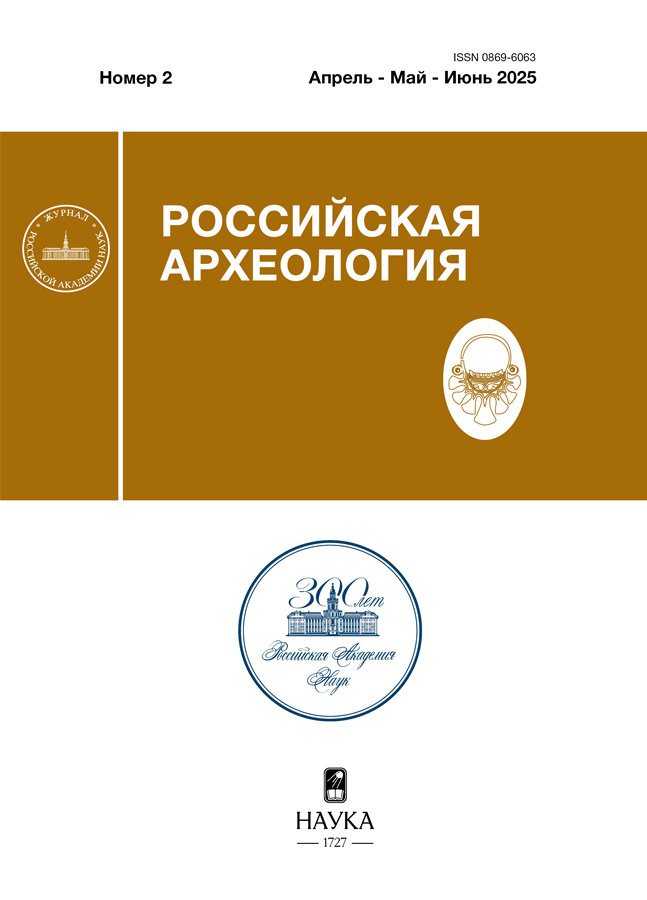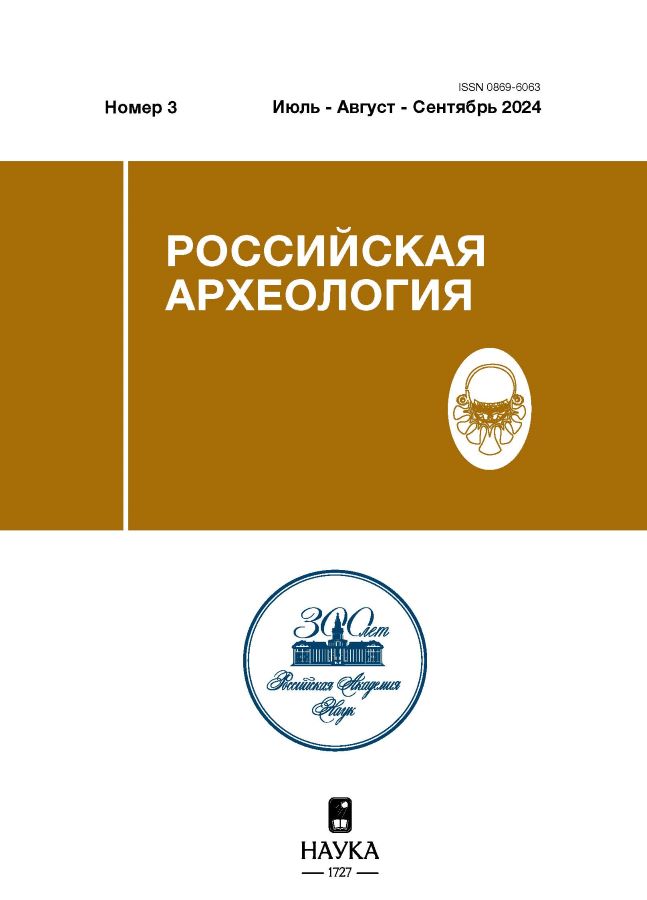The Karakuduk flint processing workshop in view of new technical and typological research
- Authors: Madreymov B.D.1
-
Affiliations:
- Karakalpak Berdakh State University
- Issue: No 3 (2024)
- Pages: 7-20
- Section: ARTICLES
- URL: https://freezetech.ru/0869-6063/article/view/655747
- DOI: https://doi.org/10.31857/S0869606324030011
- EDN: https://elibrary.ru/XAMDVD
- ID: 655747
Cite item
Abstract
The Karakuduk flint processing workshop is located in the eastern part of the Ustyurt plateau on the northern slopes of the Barsa-Kelmes depression (Republic of Karakalpakstan, a region of Uzbekistan), 1.5-2 km north of the well of the same name. The workshop was uncovered by E.B. Bizhanov in 1978. Surface finds were scattered over an area measuring 200 × 100 m. The collection includes more than 900 lithic finds. One part of them are flinty limestone plates, the other part includes flakes obtained from them. The size of the plates is mostly within 5–10 cm (sometimes bigger), the thickness is on average 1.5-2 cm. The length of most flakes is 2–3 cm (sometimes up to 5 cm). A series of bifacially processed tools was also revealed at the site. E.B. Bizhanov noted different degrees of preservation of artefact surfaces (the collection has not been studied in detail); all of the objects were attributed to the Acheulian. In this article, the author employs the technical and typological method as well as the “deflation rate” method (Derevianko et al., 2000, p. 204) to divide the artifacts from the site into three complexes. These are: Early Paleolithic including 86 items with strong surface deflation; Middle Paleolithic including 703 items with desert tan on the surface, in terms of cultural features they are included in the bifacial faction; and Late Paleolithic – 44 items which only have a patina.
Keywords
Full Text
About the authors
Berik D. Madreymov
Karakalpak Berdakh State University
Author for correspondence.
Email: bmadreymov@inbox.ru
Uzbekistan, Nukus, Karakalpakstan
References
- Alpysbaev X.A., 1959. Finds of the Lower Paleolithic in Southern Kazakhstan. Trudy Instituta arkheologii i etnografii Akademii nauk Kazakhskoy SSR [Proceedings of the Institute of Archaeology and Ethnography at the Academy of Sciences of the Kazakh SSR], 7. Alma-Ata: Nauka, pp. 232–241. (In Russ.)
- Alpysbaev X.A., 1960. Discovery of the Lower Paleolithic in Kazakhstan. Vestnik Akademii nauk Kazakhskoy SSR [Bulletin of the Academy of Sciences of the Kazakh SSR], 5, pp. 59–61. (In Russ.)
- Bizhanov E.B., 1979. Finds of Paleolithic sites in the southeastern Ustyurt. Vestnik Karakalpakskogo filiala Akademii nauk Uzbekskoy SSR [Bulletin of the Karakalpak Branch of the Academy of Sciences of the Uzbek SSR], 3, pp. 48–71. (In Russ.)
- Bizhanov E.B., 1988. Paleolithic of the Ustyurt (some research problems). Vestnik Karakalpakskogo filiala Akademii nauk Uzbekskoy SSR [Bulletin of the Karakalpak Branch of the Academy of Sciences of the Uzbek SSR], 1, pp. 68–71. (In Russ.)
- Derevyanko A.P., Petrin V.T., Tseveendorzh D., Devyatkin E.V., Larichev V.E., Vasil'evskiy R.S., Zenin A.N., Gladyshev S.A., 2000. Kamennyy vek Mongolii: Paleolit i neolit severnogo poberezh'e Doliny ozer [The Stone Age of Mongolia: Paleolithic and Neolithic on the northern coast of the Lake Valley]. Novosibirsk: Izdatel'stvo Instituta arkheologii i etnografii Sibirskogo otdeleniya Rossiyskoy akademii nauk. 440 p.
- Dolukhanov P.M., 1977. Activities of the paleogeographical detachment in Western Turkmenistan. Arkheologicheskie otkrytiya 1976 g. [Archaeological discoveries of 1976]. Moscow: Nauka, pp. 549–560. (In Russ.)
- Kasymov M.R., 1972. Kremneobrabatyvayushchie masterskie i shakhty kamennogo veka Sredney Azii [Flint processing workshops and mines of the Stone Age in Central Asia]. Tashkent: Fan. 159 p.
- Kasymov M.R., Krizhevskaya L.Ya., 1969. On the classification of flint processing workshops. Sovetskaya arkheologiya [Soviet archaeology], 1, pp. 265–268. (In Russ.)
- Lyubin V.P., 1965. On the methods for studying Lower Paleolithic stone tools. Paleolit i neolit SSSR [Paleolithic and Neolithic of the USSR], 5. P.I. Boriskovskiy, ed. Moscow: Izdatel'stvo Akademii nauk SSSR, pp. 7–75. (Materialy i issledovaniya po arkheologii SSSR, 131). (In Russ.)
- Lyubin V.P., 1984. Paleolithic of Turkmenistan (history of research, new materials, immediate objectives). Sovetskaya arkheologiya [Soviet archaeology], 1, pp. 26–45. (In Russ.)
- Medoev A.G., 1970. Areas of the Paleolithic cultures of Sary-Arka. Po sledam drevnikh kul'tur Kazakhstana [In the footsteps of the ancient cultures of Kazakhstan]. Alma-Ata: Nauka, pp. 200–216. (In Russ.)
- Pelegrin J., 1991. Sur une recherche technique expérimentale des techniques de débitage laminaire. Archéologie expérimental, 2. La terre. L'os et la pierre, la maison et les champs: actes du Colloque International “Expérimentation en archeologie: bilan et perspectives” (Archéodrome de Beaune; 6–9 avril 1988). Paris, pp. 118–128.
- Sayfullaev B.Қ., 2022. Ўrta Zarafshon voҳasi tosh davri madaniyatlari (Zirabuloқ topilmazhoyi materiallari asosida) [Orta Zarafshan oasis of Stone Age cultures (based on materials from the Zirabulok site)]. Samarқand: Samarkandskiy gosudarstvennyy universitet. 385 p.
- Vinogradov A.V., 1981. Drevnie okhotniki i rybolovy sredneaziatskogo mezhdurech'ya [Ancient hunters and fishermen of the Central Asian interfluve]. Moscow: Nauka. 173 p.
- Vinogradov A.V., Bizhanov E.B., 1978. The first Paleolithic finds from the southeastern Ustyurt. Arkheologicheskie otkrytiya 1977 g. [Archaeological discoveries of 1977]. Moscow: Nauka, p. 522. (In Russ.)
- Vishnyatskiy L.B., 1996. Paleolit Sredney Azii i Kazakhstana [Paleolithic of Central Asia and Kazakhstan]. St. Petersburg: Evropeyskiy dom. 213 p.
- Vishnyatskiy L.B., Khamrakuliev S., 1986. Stone Age workshops in the Yangaji area. Izvestiya Akademii nauk Turkmenskoy SSR. Izvestiya Akademii nauk Turkmenskoy SSR. Seriya obshchestvennykh nauk [News of the Academy of Sciences of the Turkmen SSR. Social Science Series], 2, p. 47. (In Russ.)
Supplementary files


















